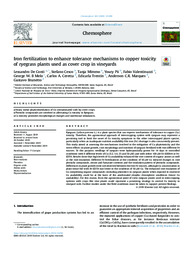Iron fertilization to enhance tolerance mechanisms to copper toxicity of ryegrass plants used as cover crop in vineyards.
Iron fertilization to enhance tolerance mechanisms to copper toxicity of ryegrass plants used as cover crop in vineyards.
Autoria: DE CONTI, L.; CESCO, S.; MIMMO, T.; PII, Y.; VALENTINUZZI, F.; MELO, G. W. B. de; CERETTA, C. A.; TRENTIN, E.; MARQUES, A. C. R.; BRUNETTO, G.
Resumo: Ryegrass (Lolium perenne L.) is a plant species that can express mechanisms of tolerance to copper (Cu) toxicity. Therefore, the agronomical approach of intercropping system with ryegrass may represent a promising tool to limit the onset of Cu toxicity symptoms in the other intercropped plants species, particularly when an inadequate nutrient availability like iron (Fe) shortage is also concurrently present. This study aimed at assessing the mechanisms involved in the mitigation of Cu phytotoxicity and the stress effects on plant growth, root morphology and nutrition of ryegrass fertilized with two different Fe sources. To this purpose, seedlings of ryegrass were hydroponically grown for 14 days in controlled conditions with 4 different levels of Cu (0.2, 5.0, 25 and 50 μM) and with either 100 μM Fe-EDDHA or Fe-EDTA. Results show that high levels of Cu availability enhanced the root content of organic anions as well as the root exudation. Different Fe fertilizations at the condition of 50 μM Cu induced changes in root phenolic compounds, citrate and fumarate contents and the exudation pattern of phenolic compounds. Differences in plant growth were not observed between the two Fe sources, although Cu concentration in plant tissue fed with Fe-EDTA was lower in the condition of 50 μM Cu. The enhanced root exudation of Cu-complexing organic compounds (including phenolics) in ryegrass plants when exposed to excessive Cu availability could be at the basis of the ameliorated edaphic rhizosphere conditions (lower Cu availability). For this reason, from the agronomical point of view ryegrass plants used in intercropping systems with crops like vine plants could represent a promising strategy to control Cu toxicity in vineyard soils. Further studies under the field conditions must be taken to support present findings.
Ano de publicação: 2020
Tipo de publicação: Artigo de periódico
Unidade: Embrapa Uva e Vinho
Palavras-chave: Organic acids, Phenolics
Observações
1 - Por padrão são exibidas publicações dos últimos 20 anos. Para encontrar publicações mais antigas, configure o filtro ano de publicação, colocando o ano a partir do qual você deseja encontrar publicações. O filtro está na coluna da esquerda na busca acima.
2 - Para ler algumas publicações da Embrapa (apenas as que estão em formato ePub), é necessário ter, no celular ou computador, um desses softwares gratuitos. Sistemas Android: Google Play Livros; IOS: iBooks; Windows e Linux: software Calibre.
Acesse outras publicações
Acesse a Base de Dados da Pesquisa Agropecuária (BDPA) para consultar o acervo completo das bibliotecas da Embrapa.

